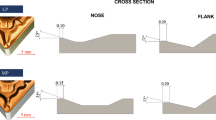Abstract
The microbevel method for increasing the rake angle of carbide tools was investigated. Relationship between the microbevel width, angle and the fracture of the cutting edge was established for cutting dry western hemlock knots. Also wear rate of microbevelled tool was investigated. Relatively small microbevel widths at a 30° bevel angle completely prevented edge and corner breakage of carbide tools with rake angles up to 50. Unbevelled carbide tools failed at rake angles larger than 30°. Tool life was not affected by the microbevel.
Zusammenfassung
Das häufig verwendete Verfahren, an Hartmetall-bestückten Schneiden einen sog. Mikro-Fasenwinkel zur Vergrößerung des Spanwinkels anzubringen, wurde untersucht. Festgestellt wurden die Bezichungen zwischen der Breite der Fasenfläche, dem Fasenwinkel und dem Schneidenausbruch, beim Schneiden von trockenem Western-Hemlock Astholz Ebenso wurde der Grad der Abstumpfung der mit einer Mikro-Fase versehenen Werkzeuge untersucht. An Hartmetallwerkzeugen mit spanwinkeln bis zu 50° verhinderten relativ schmale Fasen mit rd. 30° Ausbrüche an den Schneiden und ihren Ecken vollständig. Hartmetallwerkzeuge ohne Fase brachen schon bei Spanwinkeln von etwas mehr als 30 aus. Die Gesamtstandzeit der Werkzeuge wurde durch die Fase nicht verändert.
Similar content being viewed by others
Literature
Kirbach, E.; Bonac, T. 1979: Minimum clearance angle required for ripsawing some softwoods. Pro. Sixth Wood Mach. Seminar. Forest Prod. Lab., Richmond, Calif. pp 139–153
Kirbach, E.; Bonac, T. 1981: Influence of grinding direction and wheel translation on microsharpness of cemented tungsten-carbide tips. Holz Roh- Werkstoff 39 (7):265–270
Kivimaa, E.; Konvanen, M. 1953: Microsharpening of veneer lathe knives. Translation, Commonwealth of Australia CSIRO (1958), No. 3907, (Transl, from Valtion teknillinen tutkimuslaitos. Tiedoitus No. 126: pp 21)
Leney, L. 1960: Mechanism of veneer formation at the cellular level. Univ. of Missouri, College of Agric., Res. Bul. 744
Author information
Authors and Affiliations
Rights and permissions
About this article
Cite this article
Bonac, T. Microbevel for cemented tungsten carbide wood cutting tools. Holz als Roh-und Werkstoff 40, 411–413 (1982). https://doi.org/10.1007/BF02609584
Issue Date:
DOI: https://doi.org/10.1007/BF02609584



